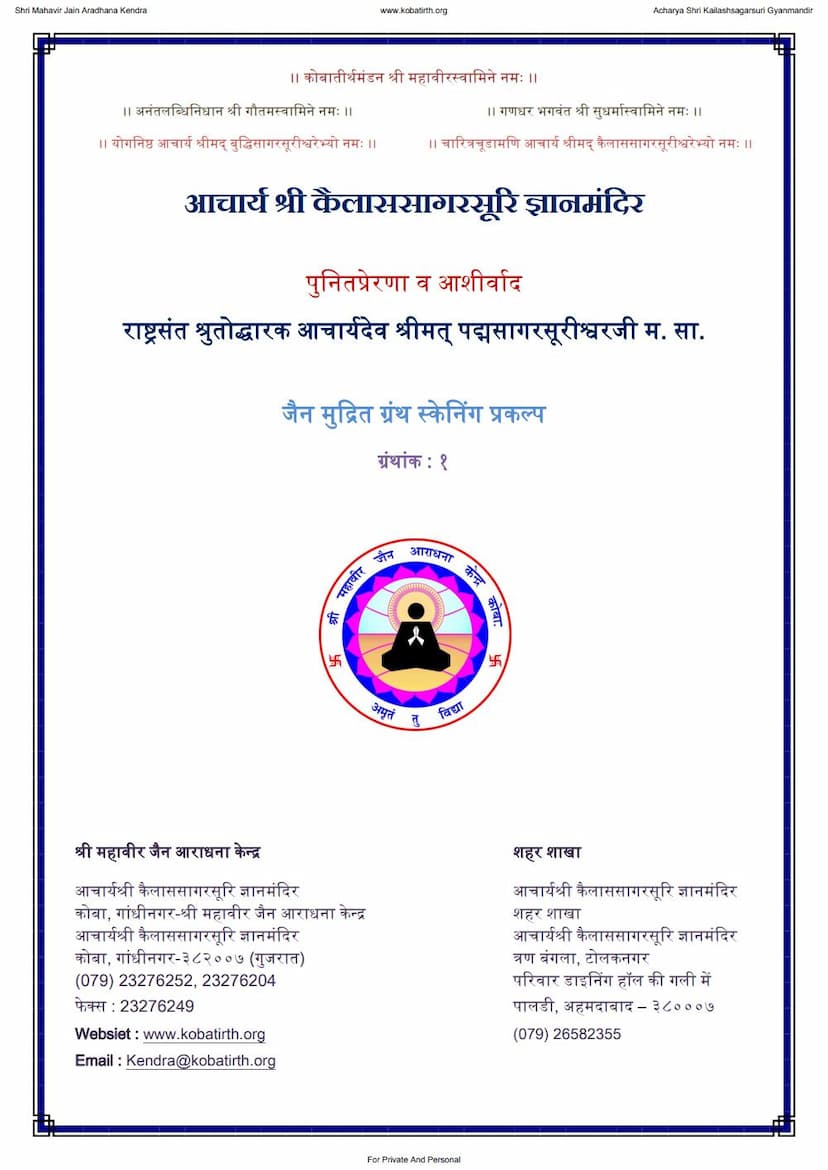Antaray Karm Nivaran Pooja
Added to library: September 1, 2025

Summary
Here's a comprehensive summary of the Jain text "Antaray Karm Nivaran Pooja" based on the provided pages:
Book Title: Antaray Karm Nivaran Pooja ( Pooja for the Removal of Obstacle Karma) Author: Bhailal Nanalal Mashruwala Publisher: Bhailal Nanalal Mashruwala Catalog Link: https://jainqq.org/explore/020044/1
This book, "Antaray Karm Nivaran Pooja," is a Jain devotional text focused on understanding and overcoming "Antaray Karma" (obstacle karma) through a series of specific pujas (worship rituals). The text is attributed to the inspiration and guidance of Pujya Padma Sadhvi Shri Shantishriji, a disciple of Pujya Padma Sadhvi Shri Rupashriji of the Vimal Gachhi lineage. The publication was facilitated by Bhailal Nanalal Mashruwala, with financial assistance from Sh. Punjiram Bhaychand of Harsel.
Core Concept: Antaray Karma
The central theme of the book is Antaray Karma, a type of karma in Jainism that obstructs or hinders the experience of positive qualities and actions. The text explains that even in human life, which is considered precious and conducive to spiritual progress, individuals often bind this karma by speaking negatively about good deeds or by directly obstructing others' virtuous activities. The book aims to elucidate the nature of this karma and provide a means to overcome it.
The Eight Types of Pujas for Obstacle Karma Removal
The primary content of the book consists of detailed descriptions and explanations of eight specific pujas, each aimed at neutralizing a particular type of Antaray Karma. These pujas are presented with accompanying verses (Duhas and Dhals), their meanings, and illustrative stories (Drishtants) to reinforce the teachings.
The eight pujas and their associated objectives are:
-
Jal Pooja (Water Puja): This puja is performed to remove the obstacle karma related to Dana (Charity). The verses detail various transgressions that lead to this karma, such as hindering charitable acts, speaking ill of scriptures, neglecting ascetics, and causing harm to living beings. The story of Somashri illustrates the power of water puja in overcoming obstacles.
-
Chandan Pooja (Sandalwood Puja): This puja aims to remove the obstacle karma of Dana (Charity). The verses highlight the negative consequences of miserliness and the importance of giving. The story of King Jaysoor and Queen Shubhmati demonstrates how sandalwood puja can lead to spiritual liberation.
-
Pushpa Pooja (Flower Puja): This puja is dedicated to removing the obstacle karma of Labh (Gain/Profit). The verses explain how ill deeds and negative associations can lead to this karma, while positive actions and devotion bring prosperity and spiritual progress. The story of Leelavati, a merchant's daughter, showcases the benefits of flower puja.
-
Dhoop Pooja (Incense Puja): This puja is performed to remove the obstacle karma related to Bhog (Enjoyment of senses). The verses describe how obstructing the enjoyment of others or experiencing negative karma can lead to hindrances in one's own enjoyment. The story of King Vinayadhar illustrates how incense puja can overcome obstacles related to enjoyments.
-
Deepak Pooja (Lamp Puja): This puja targets the obstacle karma of Upbhog (Consumption/Use). The verses emphasize the importance of spiritual knowledge and correct actions in overcoming hindrances to experiencing things. The story of Jinmati and Dhanshri highlights the benefits of lamp puja in gaining wisdom and overcoming obstacles.
-
Akshat Pooja (Unbroken Rice Puja): This puja is performed to remove the obstacle karma of Veerya (Energy/Valor). The verses explain that this karma can weaken one's strength and resolve. The story of the parrot couple illustrates how Akshat puja can lead to immense spiritual and material benefits.
-
Naivedya Pooja (Food Offering Puja): This puja is aimed at removing obstacles related to Siddha Pad (the state of liberation) by offering pure food. The verses emphasize detachment from worldly desires and the pursuit of the ultimate state of liberation. The story of King Hulli demonstrates how naivedya puja can lead to prosperity and spiritual progress.
-
Phal Pooja (Fruit Puja): This puja is performed to remove the obstacle karma of the eight karmas in general, leading to the ultimate fruit of liberation. The verses highlight that by offering fruits to the divine, one can attain the fruit of liberation. The stories of the parrot couple and a poor woman illustrate the power of fruit puja.
Key Themes and Principles:
- Importance of Devotion and Righteous Action: The book consistently emphasizes that sincere devotion and performing virtuous deeds, specifically through the prescribed pujas, are the keys to overcoming Antaray Karma.
- Consequences of Negative Actions: The text details how specific negative actions, such as speaking ill, hindering others, miserliness, and harboring negative intentions, lead to the binding of Antaray Karma.
- Power of Jain Rituals: The eight pujas are presented as potent methods to cleanse oneself of these karmic obstructions, leading to spiritual advancement and worldly well-being.
- Illustrative Stories: The inclusion of relatable stories serves to demonstrate the practical application and effectiveness of these pujas, making the teachings more accessible and inspiring.
- Guidance from Ascetics: The book highlights the role of spiritual teachers (gurus) in guiding devotees and revealing the path to liberation.
- The Goal of Liberation (Moksha): Ultimately, the purpose of performing these pujas is to purify the soul, break free from the cycle of birth and death, and achieve Moksha (liberation).
Overall Purpose:
"Antaray Karm Nivaran Pooja" serves as a practical guide for Jains to understand and actively combat the impediments to their spiritual growth and well-being. By engaging in these specific devotional practices, followers are encouraged to purify their intentions, rectify past misdeeds, and progress towards a life free from obstacles and ultimately towards the ultimate goal of liberation.